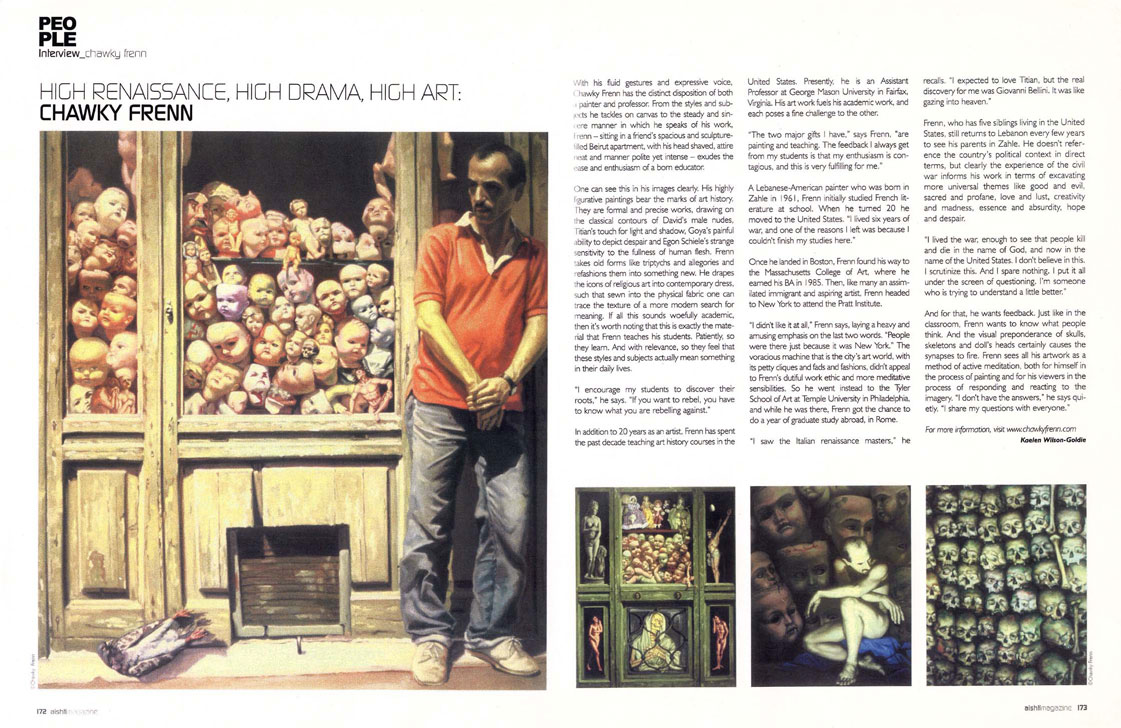High Renaissance, High Drama, High Art: Chawky Frenn

With his fluid gestures and expressive voice, Chawky Frenn has the distinct disposition of both a painter and professor. From the styles and subjects he tackles on canvas to the steady and sincere manner in which he speaks of his work, Frenn - sitting in a friend's spacious and sculpture lied Beirut apartment, with his head shaved, attire neat and manner polite yet intense - exudes the case and the enthusiasm of a born educator.
One can see this in his images clearly. His highly figurative paintings bear the marks of art history. They are funnel and precise works, drawing on the classical contours of David's male nudes, Titan’s touch for light and shadow, Goya's painful ability to depict despair and Egon Schiele's strange sensitivity to the fullness of human flesh. Frenn takes old forms like triptychs and allegories and refashions them into something new. He drapes the icons of religious art into contemporary dress, such that sewn into the physical fabric one can trace the texture of a more modern search for meaning. If all this sounds woefully academic, then it's worth noting that this is exactly the material that Frenn teaches his students. Patiently, so they learn. And with relevance, so they feel that these styles and subjects actually mean something in their daily lives.
"I encourage my students to discover their roots,” he says. "If you want to rebel, you have to know what you are rebelling against.”
In addition to 20 years as an artist, Frenn has spent the past decade teaching art history courses in the United States. Presently, he is an Assistant Professor at George Mason University in Fairfax, Virginia. His artwork fuels his academic work, and each poses a fine challenge to the other.
"The two major gifts I have," says Frenn,"are painting and teaching. The feedback I always get from my students is that my enthusiasm is contagious, and this is very fulfilling for me.”
A Lebanese-American painter who was born in Zahle in 1961 ,Frenn initially studied French literature at school. When he turned 20 he moved to the United States. "I lived six years of war, and one of the reasons I left was because I couldn't finish my studies here."
Once he landed in Boston, Frenn found his way to the Massachusetts College of Art, where he earned his BA in 1985. Then, like many an assimilated immigrant and aspiring artist. Frenn headed to New York to attend the Pratt Institute.
"I didn't like it at all," Frenn says, laying a heavy and amusing emphasis on the last two words. "People were there just because it was New York." The voracious machine that is the city's artworld, with its petty cliques and fads and fashions, didn't appeal to Frenn's dutiful work ethic and more meditative sensibilities. So he went instead to the Tyler School of Art at Temple University in Philadelphia, and while he was there, Frenn got the chance to do a year of graduate study abroad, in Rome.
"I saw the Italian renaissance masters." here calls. I expected to love Titian, but the real discovery for me was Giovanni Bellini. It was like gazing into heaven."
Frenn, who has five siblings living in the United States. still returns to Lebanon every few years to see his parents in Zahle. He doesn't reference the country's political context in direct terms, but clearly the experience of the civil war informs his work in terms of excavating more universal themes like good and evil, sacred, and profane. love and lust, creativity and madness, essence and absurdity, hope and despair.
"I lived the war, enough to see that people kill and die in the name of God, and now in the name of the United States. I don't believe in this. I scrutinize this. And I spare nothing. I put it all under the screen of questioning. I'm someone who is trying to understand a little better.''
And for that, he wants feedback. Just like in the classroom, Frenn wants to know what people think. And the visual preponderance of skulls, skeletons and doll's heads certainly causes the synapses to fire. Frenn sees all his artwork as a method of active meditation, both for himself in the process of painting and for his viewers in the process of responding and reacting to the imagery. “I don't have the answers," he says quietly."I share my questions with everyone."
